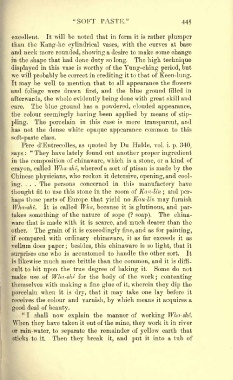Page 475 - Chinese Porcelain Vol II, Galland
P. 475
"SOFT PASTE." 445
excellent. It will be noted that in form it is rather plumper
than the Kang-he cylindrical vases, with the curves at base
and neck more rounded, showing a desire to make some change
in the that had done so The
shape duty long. high technique
displayed in this vase is worthy of the Yuug-ching period, but
we will be correct in it to that of Keen-lung.
probably crediting
It may be well to mention that to all appearance the flowers
and foliage were drawn first, and the blue ground filled in
afterwards, the whole evidently being done with great skill and
care. The blue ground has a powdered, clouded appearance,
the colour seemingly having been applied by means of stip-
The in this case is more and
pling. porcelain transparent,
has not the dense white common to this
opaque appearance
class.
soft-paste
Pere d'Entrecolles, as quoted by Du Halde, vol. i. p. 340,
"
says : They have lately found out another proper ingredient
in the composition of chinaware, which is a stone, or a kind of
called Wha-she, whereof a sort of is made the
crayon, ptisan by
Chinese physicians, who reckon it detersive, opening, and cool-
. The concerned in this have
ing. . . persons manufactory
thought fit to use this stone in the room of Kau-lin ; and per-
haps those parts of Europe that yield no Kau-lin may furnish
Wha-she. It is called Wha, because it is glutinous, and par-
takes something of the nature of sope (? soap). The china-
ware that is made with it is scarce, and much dearer than the
other. The grain of it is exceedingly fine, and as for painting,
if compared with ordinary chinaware, it as far exceeds it as
vellum does paper ; besides, this chinaware is so light, that it
one who is accustomed to handle the other sort. It
surprises
is likewise much more brittle than the common, and it is diffi-
cult to hit upon the true degree of baking it. Some do not
make use of Wha-she for the body of the work; contenting
themselves with making a fine glue of it, wherein they dip the
porcelain when it is dry, that it may take one lay before it
receives the colour and varnish, by which means it acquires a
good deal of beauty.
"
I shall now the manner of working Wha-she.
explain
When they have taken it out of the mine, they work it in river
or rain-water, to separate the remainder of yellow earth that
sticks to it. Then they break it, and put it into a tub of

